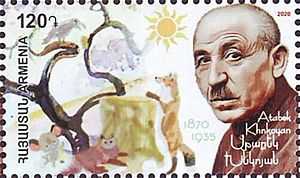Khnko Aper facts for kids
Quick facts for kids
Khnko Aper
|
|
|---|---|

Khnkoyan on a 2020 stamp of Armenia
|
|
| Born |
Atabek Hovhannesi Khnkoyan
19 October 1870 Village of Gharaboya, Lori Region, Russian Armenia (now village of Khnkoyan)
|
| Died | 8 October 1935 (aged 64) |
| Nationality | Armenian |
| Occupation | writer |
Atabek Khnkoyan (Armenian: Աթաբեկ Հովհաննեսի Խնկոյան, born October 19, 1870 – died October 8, 1935) was an Armenian writer. He is famous for writing under his pen name, Khnko Aper (Armenian: Խնկո Ապեր). He wrote many stories and poems especially for children. He is one of Armenia's most loved children's authors.
Contents
Who Was Khnko Aper?
Khnko Aper, whose real name was Atabek Khnkoyan, was born in a village called Gharaboya. This village is in the Lori region of Armenia. He started his schooling in his home village. Later, he continued his education in a city then known as Alexandropol (now called Gyumri).
Khnko Aper as a Teacher
From 1890 to 1910, Khnko Aper worked as a teacher. He taught in many Armenian schools across Transcaucasia. He also wrote for several magazines. These included Ashkhatavor (The Laborer) and Aghbiur (The Fountain). He even wrote for Hasker (Spikes), which was a special monthly magazine for children.
Life in Armenia
After the Soviet Union was formed, Khnko Aper moved to Armenia. There, he continued his work as a writer and educator. He wrote several textbooks to help Armenian children learn their native language. Two of his well-known textbooks were Mer Dbrotse (Our School) and Karmir arev (Crimson Sun).
Khnko Aper's Writings
Khnko Aper mainly wrote literature for children. He created many fables, legends, and poems. He wrote both original stories and translated others. In total, he published about 120 books.
Famous Works for Children
Some of his most famous works include:
- Giughatsin yev arje (The Peasant and the Bear, 1909)
- Gogh makin (The Lamb Thief, 1911)
- Pesatsu muke (Mouse, the Intended Bridegroom to Be, 1912)
- Arakner (Parables, 1917)
- Tranvaye Yerevanum (The Yerevan Streetcar, 1934)
- Mknern inchpes grvestin katvi tem (How the Mice Fought the Cat, 1936)
- Kkozn agrave (The Pig and the Crow, 1940)
- Gayln u katun (The Wolf and the Cat, 1957)
- Mkneri zhoghove (The Council of Mice, 1957)
Khnko Aper was known for using different Armenian dialects and everyday language in his writing. This made his stories and poems very charming and easy to read for everyone.
He passed away in Yerevan in 1935. He was buried in the Komitas Pantheon, a famous cemetery in Yerevan.

